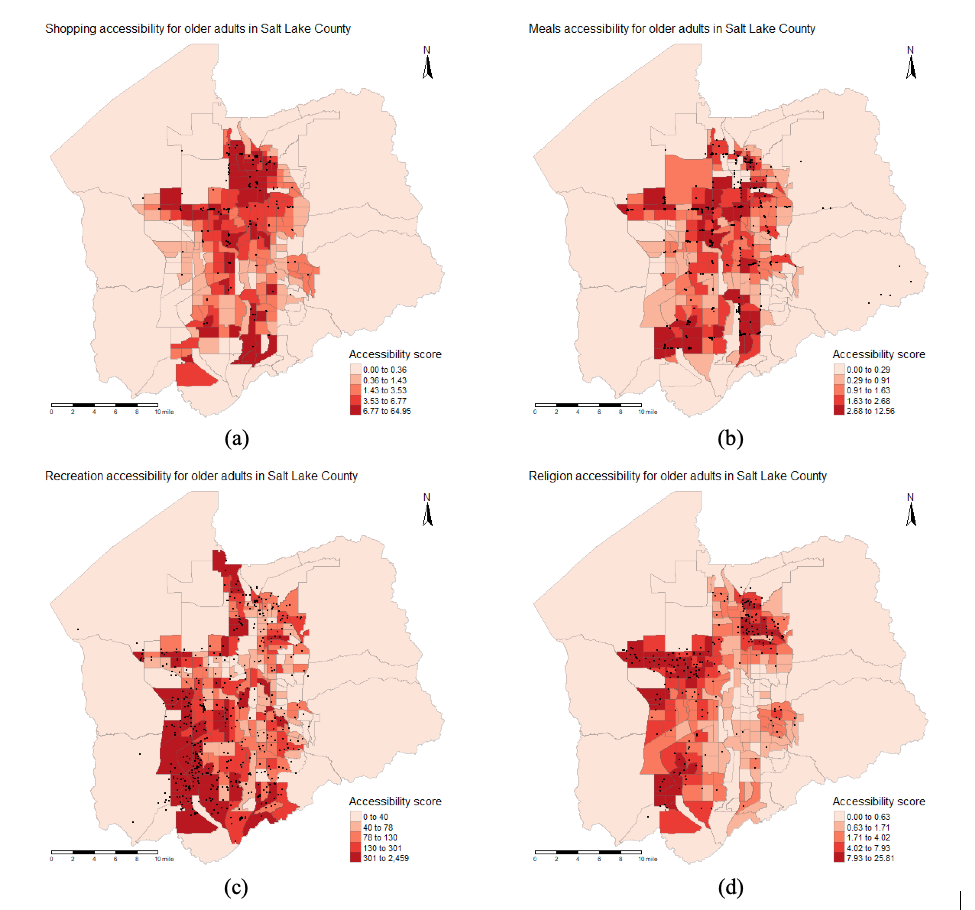Studying and Calculating Accessibility for Older Adults in Utah

When developing a city’s infrastructure, considering the needs of every demographic is vital for the health and success of the community. One vulnerable group is older adults (defined in this project as people aged fifty or older). The purpose of the project, called "Understanding Travel Behavior and Accessibility for Older Adults: A Comprehensive Framework," was to learn about the transportation habits of older adults and develop a way to mathematically measure accessibility (the ability to access transportation) of older adults. Researchers from the University of Utah used those findings to understand the challenges older adults faced. They hope that their findings will be used to improve older adults’ lives and, in turn, the lives of those around them.
To examine the travel behavior of older adults, the researchers employed two strategies: they distributed a survey and conducted a focus group. They reached 724 older adults with the survey, which was distributed across the state of Utah in paper and online formats. In the survey, participants were asked to rank their four most preferred activities and answer questions regarding transportation to and from those activities. Using those responses, the researchers measured the older adults’ travel behaviors and travel satisfaction. Travel behaviors were measured using travel frequency, travel time, and travel distance. Travel satisfaction was measured on a scale with five options: dissatisfied, somewhat dissatisfied, neutral, somewhat satisfied, and satisfied. Watch the recording of a November 2023 webinar to learn about the findings in more detail.
The focus group was conducted with eighteen older adults who participated in the survey. The interviews were audio-recorded and analyzed to quantify transportation modes, current travel behaviors, future travel behaviors, and attitudes.
Several themes emerged from the survey and focus group:
- The demographic factors with the most influence over frequency of travel were health and income; older adults who were in better health or had a higher income traveled more frequently.
- Urban residence was associated with shorter travel time and distance compared to suburban or rural living.
- Travel satisfaction was influenced by age, income, urban residence, health status, and use of assistive devices such as walkers. Overall health had the greatest positive correlation with travel satisfaction; usage of assistive devices had the greatest negative correlation.
- Participants who used assistive equipment traveled a fewer number of times but spent more time on each excursion.
- Survey participants traveled most for social activities.
To determine the accessibility of older adults, researchers
- created catchment areas around supply-to-demand ratio, and
- generated catchment areas around demand points and aggregating the supply-to-demand ratios from nearby supply points.
What does all that mean? For this project, a “catchment area” is a geographic region within which a person can travel in sixty minutes. “Supply” in “supply-to-demand” refers to a location that an older person might want to go to, and “demand” refers to where the older person lives. The figure below shows the accessibility of shopping, meals, recreation, and religion in Salt Lake City and Murray. The darker color a region is, the more accessible it is.
The results of the accessibility calculation revealed that accessibility was lower in eastern and western suburbs than it was in the downtown area. Also, accessibility was higher for religion and recreation and lower for shopping. Importantly, the results of the accessibility calculation were based on a sample of relatively healthy older adults who still drive; specific populations with different needs require further attention.
Overall, the researchers found significant dissatisfaction and vulnerability in older adults with limited mobility. They documented a positive relationship between travel frequency and satisfaction up to a certain threshold, beyond which satisfaction declined. The results emphasize the importance of considering the diverse dimensions of older adults’ needs and developing distinct accessibility measures for groups that may find travel more difficult, such as those with disabilities or lower income.
In sum, the aging population is diverse, so accommodating them requires diverse solutions. A non-linear relationship exists between travel frequency and travel satisfaction, and that threshold warrants further investigation. Since this accessibility calculation only considered driving, taking multiple modes of travel into consideration would be useful in future work.
This research was funded by the National Institute for Transportation and Communities, with additional support from the University of Utah's City and Metropolitan Planning department and Center on Aging.
ABOUT THE PROJECT
Understanding Travel Behavior and Accessibility for Older Adults: A Comprehensive Framework
E-Sok Andy Hong, University of Utah; Xiaoyue Cathy Liu, University of Utah
Photo by walencienne/iStock
The National Institute for Transportation and Communities (NITC) is one of seven U.S. Department of Transportation national university transportation centers. NITC is a program of the Transportation Research and Education Center (TREC) at Portland State University. This PSU-led research partnership also includes the Oregon Institute of Technology, University of Arizona, University of Oregon, University of Texas at Arlington and University of Utah. We pursue our theme — improving mobility of people and goods to build strong communities — through research, education and technology transfer.

